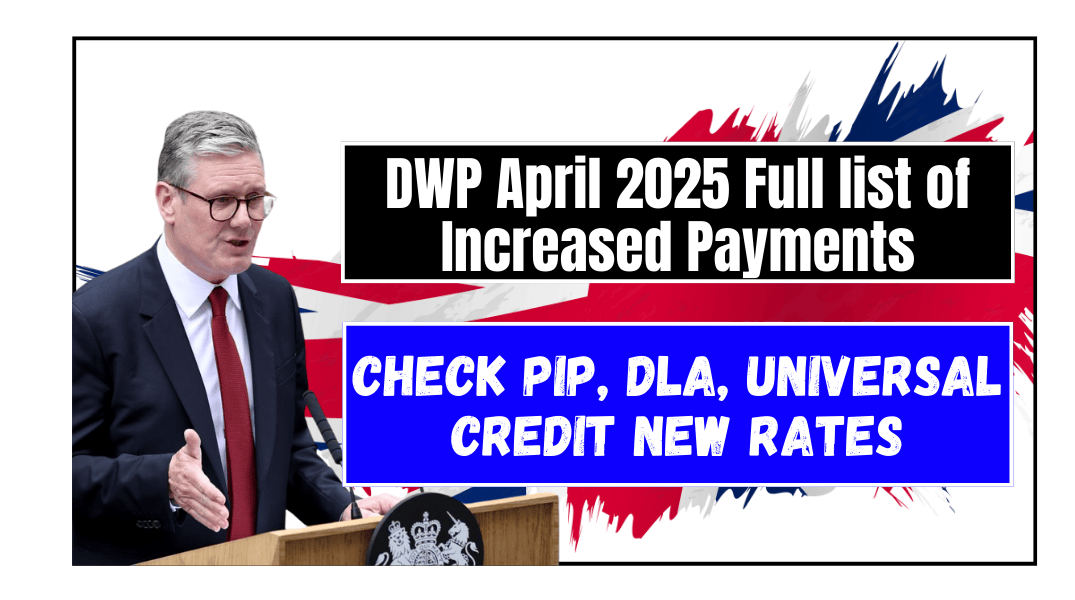DWP April 2025 Full list of Increased Payments: The UK Government’s Spring Statement has drawn mixed reactions, with many campaigners and some Labour members criticizing cuts to Personal Independence Payments (PIP). However, there is some good news for benefit claimants, as millions are set to benefit from increased payments, aimed at helping to alleviate the ongoing cost-of-living crisis.
The Department for Work and Pensions (DWP) has announced a 1.7% increase for PIP and Universal Credit (UC) recipients, with pensioners seeing a bigger hike of 4.1% on their claims. Although the increases are not the same for everyone, they provide some financial relief for those who rely on these benefits.
Personal Independence Payments (PIP) are designed to support individuals diagnosed with an illness or disability who struggle with everyday tasks. PIP is awarded based on a points system and is not means-tested, which means it’s available to both employed and unemployed individuals.
Here’s a breakdown of the PIP increase:
- Daily living component (enhanced rate): £108.55 → £110.40
- Daily living component (standard rate): £72.65 → £73.90
- Mobility component (enhanced rate): £75.75 → £77.05
- Mobility component (standard rate): £28.70 → £29.20
In a more controversial move, the government has announced plans to tighten the rules for PIP, which could result in between 800,000 and 1.2 million claimants losing out on benefits. These changes to the qualifying criteria for the daily living element are set to take effect in November 2026.
Universal Credit (UC) claimants will see the following increases:
- Single under 25: £311.68 → £316.98
- Single 25 or over: £393.45 → £400.14
- Couple claimants both under 25: £489.23 → £497.55
- Couple claimants (one or both are 25 or over): £617.60 → £628.10
For those with children, the changes are as follows:
- First child (born before April 6, 2017): £333.33 → £339
- Subsequent children (born after April 6, 2017): £287.92 → £292.81
- Disabled child (lower rate): £156.11 → £158.76
- Disabled child (higher rate): £487.58 → £495.87
Other Universal Credit categories also see increases, including:
- Limited work capability: £156.11 → £158.76
- Carer’s allowance: £198.31 → £201.68
- Increased work allowance (higher rate): £673 → £684
- Increased work allowance (lower rate): £404 → £411
State Pension will also rise by 4.1%, which means the annual payment will increase from £11,502.40 to £11,975. The weekly payment for State Pension claimants will rise from £221.20 to £230.25. This increase is part of the triple lock system, which ensures the state pension increases based on the highest of three figures: wage growth, 2.5%, or inflation. This year, wage growth is the highest, which has driven the increase.
Pension Credit payments will also see increases, with:
- Guaranteed Pension Credit (single claimants): £218.15 → £227.10
- Guaranteed Pension Credit (couple claimants): £332.95 → £346.60
- Disabled Pension Credit (single claimant): £81.50 → £82.90
- Disabled Pension Credit (couple claimants): £163 → £165.80
In addition, benefits such as Housing Benefit, Jobseeker’s Allowance (JSA), Maternity Allowance, Statutory Sick Pay, and Widowed Parent’s Allowance will also see 1.7% increases, which will provide some relief to those relying on these payments.
These hikes are designed to help benefit claimants manage the rising costs of living. However, changes to PIP and other benefits have sparked concerns about the future, especially with plans to reduce the number of claimants in certain categories.
FAQ’s
What benefits are seeing an increase in payments this month?
Several benefits are seeing an increase, including PIP (1.7%), Universal Credit (1.7%), Pension Credit (4.1%), State Pension (4.1%), and Carer’s Allowance (1.7%). Payments for Child Benefit, ESA, and DLA are also increasing.
How much is the increase for PIP?
The increase for PIP is 1.7%. For example, the daily living component (enhanced rate) will rise from £108.55 to £110.40, and the mobility component (standard rate) will increase from £28.70 to £29.20.
What is the increase for the State Pension?
The State Pension will rise by 4.1%, from £11,502.40 to £11,975 per year, which means weekly payments will increase from £221.20 to £230.25.
How much will Universal Credit claimants receive after the increase?
Universal Credit claimants will see a 1.7% increase in payments. For example, single claimants under 25 will see an increase from £311.68 to £316.98, while couple claimants over 25 will receive £628.10, up from £617.60.
How does the increase in Carer’s Allowance affect claimants?
Carer’s Allowance will increase by 1.7%, bringing the weekly payment from £81.90 to £83.30 for those providing care to eligible individuals.






